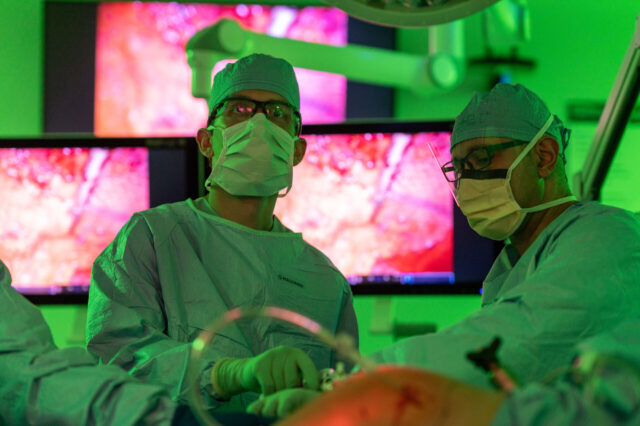Are You at Risk of a Hernia?

Almost everyone has heard of a hernia, but few understand its potential risks.
Over five million people in the United States will suffer from a hernia, yet only 15% will seek medical help
On the heels of Hernia Awareness Month in June, UF Health surgeon and hernia specialist Mazen Al-Mansour, MBBS, an assistant professor in the University of Florida Department of Surgery, offers expert advice and answers frequently asked questions about the condition.
What is a hernia?
A hernia is the protrusion of an organ, such as the intestines, through a gap in the structure or muscle that usually contains it.
There are many types of hernias and most occur in the abdominal wall between the chest and hips. Hernias may or may not cause symptoms, such as discomfort or pain. However, most require surgical repair.
A hernia can occur for many reasons: age, regular wear and tear on muscles, or as a result of a birth disorder, pregnancy or surgery.
Types of hernias
The type of hernia relates to its location:
1. Inguinal hernia
The most common abdominal wall hernia is an inguinal hernia located in the groin where the abdomen meets the thigh. This occurs when abdominal tissue, such as belly fat or intestines, bulges through an opening in the lower abdominal wall, which separates the abdomen from the groin.
Inguinal hernias are far more common in men than women.
2. Femoral hernia
A femoral hernia is a bulge in the upper part of the thigh near the groin. These hernias are more likely to occur in women than men.
Femoral hernias are uncommon, but can lead to severe problems if the hernia obstructs blood flow to the intestines.
3. Hiatal hernia
A hiatal hernia occurs when the stomach migrates into the chest through the natural hole in the diaphragm known as the hiatus. Hiatal hernias are most often seen in women over 50.
A small hiatal hernia usually does not cause problems, but a larger one can lead to regurgitation or heartburn, resulting from food and acid regressing into the esophagus. Hiatal hernias are linked to gastroesophageal reflux disease, or GERD, which causes these symptoms, particularly when lying flat or bending forward. However, some hiatal hernias can be asymptomatic.
4. Incisional hernia
An incisional hernia can develop at or close to a prior surgical incision in the abdomen.
Approximately 15% of people who undergo abdominal surgery develop incisional hernias, most often 3 to 6 months after the procedure. Incisional hernias result from a weakening of the abdominal muscle for a number of reasons, such as premature physical activity, considerable weight gain or pregnancy.
5. Umbilical hernia
Umbilical hernias occur near the belly button or navel.
Umbilical hernias occur commonly in newborns and infants. They can also occur in adults, usually those with raised abdominal pressure caused by obesity, constipation, pregnancy or straining during childbirth or weightlifting.
What does a hernia look like?
A hernia is often noticed as a bulge or swelling. It tends to enlarge throughout the day and be smaller in the morning after a good night’s rest.
Sometimes it is only noticeable when laughing, coughing or lifting a heavy object.
What does a hernia feel like?
Those with a hernia can often “push their hernia in,” which can relieve discomfort. While hernias can be painful, often they are painless or cause only mild discomfort, usually with prolonged standing or physical activity.
The sensations of food, liquid or medicine tablets getting stuck in the chest while swallowing are associated with having a hiatal hernia and are related to GERD.
Who is most at risk of a hernia?
Hernias can result from a natural weakness in the abdominal muscles or a weakness resulting from previous surgery. It is more likely to become apparent with conditions that increase intra-abdominal pressure.
Some factors include:
- Abdominal surgery: Weakens abdominal muscles
- Abdominal weight gain: Stretches the abdominal wall
- Aging: Muscles can weaken with age
- Constipation: Increases intra-abdominal pressure
- Pregnancy/birth: Unwanted strain or pressure in abdomen
- Premature birth and low birth weight
- Previous hernia/hernia repair
- Strenuous activity: Heavy lifting increases abdominal pressure
Is a hernia life-threatening?
Hernias can sometimes result in serious problems. If the intestines are trapped by the hernia, a person can develop an intestinal blockage.
When this occurs, the patient will be in severe pain.
If the hernia bulge becomes extremely rigid and does not “go back in” — a condition referred to as hernia incarceration — the patient will feel sick, can start vomiting and may stop passing gas or having bowel movements. This can progress to strangulation, when the circulation to the intestine gets cut off.
Hernia incarceration and/or strangulation are emergencies that require prompt medical evaluation and may require emergent surgery.
Diagnosing a hernia
The key to diagnosing a hernia is an evaluation by an experienced surgeon. The surgeon will check for a bulge in the abdomen or groin area.
Most inguinal hernias and abdominal hernias can be diagnosed by performing a good history and physical examination. Frequently, no further tests are needed, but imaging with a CT scan, ultrasound or MRI can be used, if diagnosis isn’t readily apparent.
However, hiatal hernias cannot be diagnosed through a physical exam and will require a diagnostic test. This may include an endoscopy procedure, passing a scope through the mouth down the esophagus and into the stomach, or imaging, CT scan or contrast X-rays.
Treating a hernia
In general, hernias will not go away on their own and they tend to enlarge over time.
Most hernias do not resolve without treatment with the exception of hernias at the navel in small children. However, some hernias with minimal symptoms can be safely monitored.
Because this decision is rather complex, consultation with a surgeon is required.
Hernia repair surgery aims at returning the internal organs to their natural location, closing the defect with sutures and sometimes the placement of surgical mesh. Mesh is a synthetic “patch” used to patch the defect and prevent hernia recurrence.
Depending on the patient, hernia repair surgery can be achieved through traditional surgery, laparoscopic surgery or robotic surgery.
